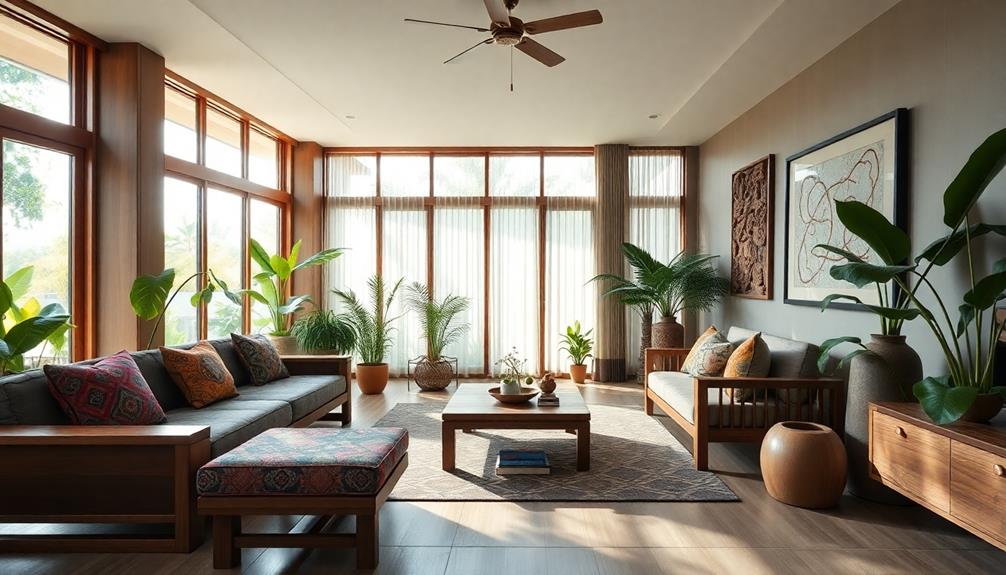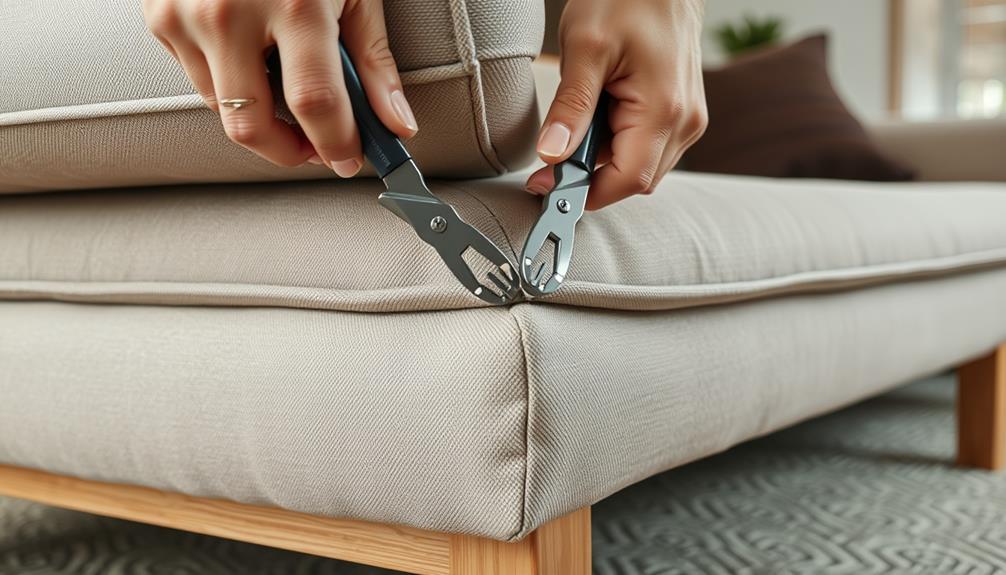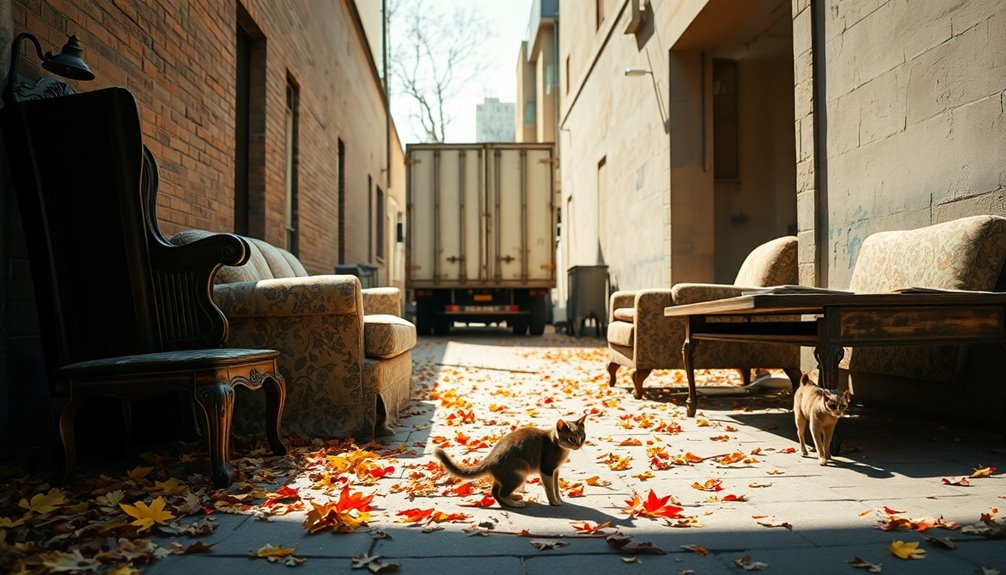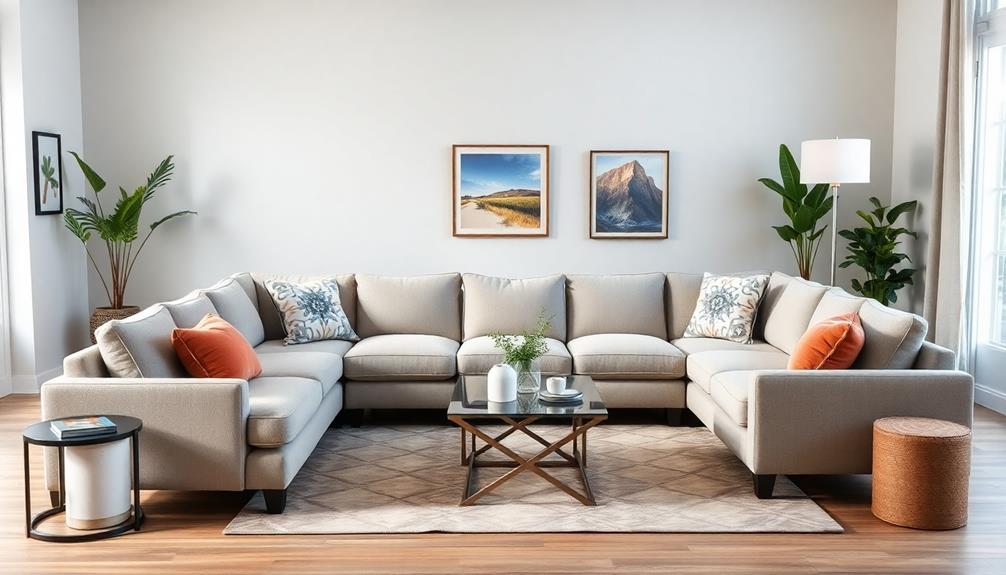Modern Indonesian interior design combines contemporary and traditional elements to create a striking aesthetic. Utilizing natural materials like sustainable timber, bamboo, and volcanic stone adds a sense of warmth and authenticity to the space. The inclusion of vibrant textiles such as batik and ikat not only showcases cultural craftsmanship but also injects energy into the room. Open layouts are incorporated to welcome natural light and improve airflow, fostering a seamless connection with the natural surroundings. Balinese influences are evident in the intricate carvings and minimalist furniture choices, further contributing to the unique fusion of cultural heritage and modern design. This marriage of tradition and innovation celebrates Indonesia’s cultural identity. If you are interested in learning more about specific designs or applications, there is a wealth of information waiting to be discovered!
Key Takeaways
- Modern Indonesian interior design blends traditional elements with contemporary aesthetics, creating unique and inviting living spaces.
- Natural materials like bamboo, teak wood, and volcanic stone emphasize sustainability and warmth in design.
- Open-plan layouts enhance airflow and connect indoor spaces with nature, fostering a serene atmosphere.
- Vibrant textiles such as batik and ikat add cultural depth and visual interest to modern interiors.
- The integration of cultural symbolism through intricate carvings and water features enriches the overall aesthetic and meaning of the space.
Overview of Indonesian Interior Design
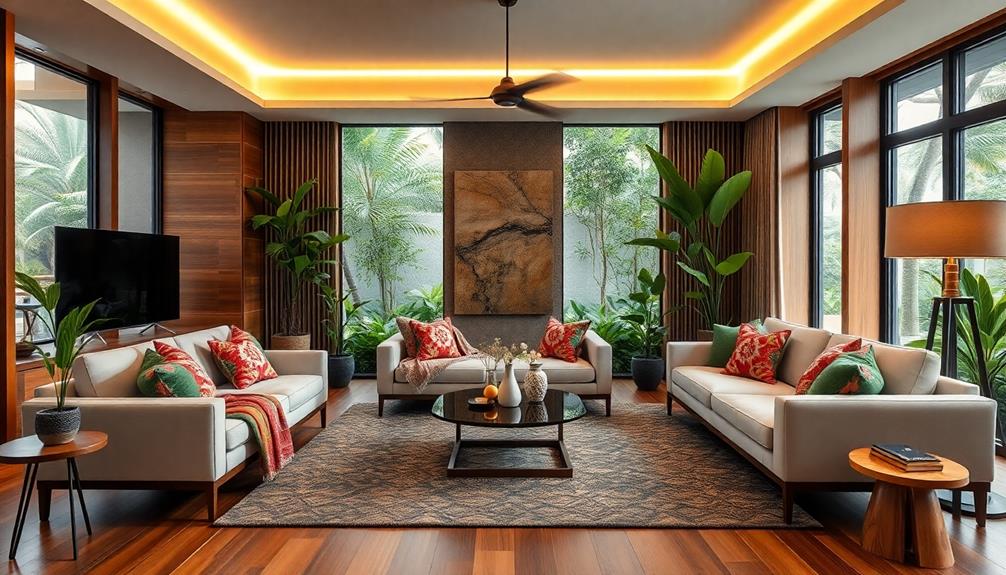
Indonesian interior design captivates with its unique blend of traditional and modern elements, creating spaces that reflect the country's rich cultural heritage. You'll notice how this design approach harmonizes natural materials like sustainable timber, bamboo, and natural fibers, emphasizing eco-friendliness.
The incorporation of vibrant textiles, such as batik and ikat, infuses color and cultural significance into modern interiors, showcasing Indonesia's artisanal craftsmanship. Additionally, Balinese design characteristics highlight the importance of sustainable practices and a connection to nature, further enriching the design narrative.
Open-plan layouts are common, promoting airflow and a seamless connection to nature. Large windows and sliding doors invite the outdoors in, elevating the overall ambiance of your space.
Contemporary Indonesian design often features minimalist furniture, complemented by intricate carvings that marry simplicity with ornate details. This balance between traditional artistry and modern aesthetics allows you to appreciate the beauty of Balinese influences in a fresh context.
Through this design philosophy, you can create living spaces that feel both timeless and current. Whether you're looking to embrace traditional elements or modernize your home, Indonesian interior design offers a perfect canvas for showcasing your style while honoring the rich heritage of this vibrant culture.
Traditional Elements in Design
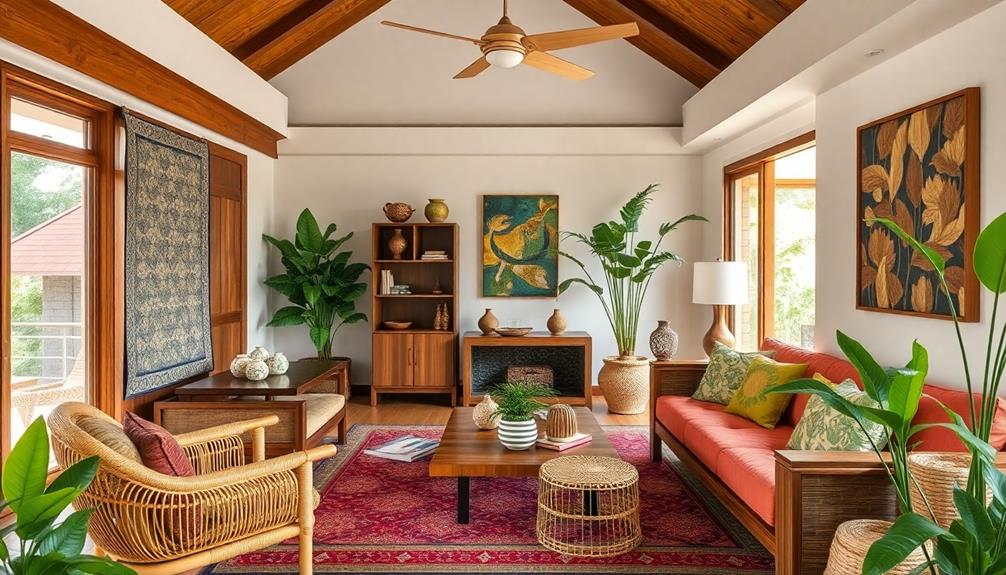
When you're exploring traditional elements in Indonesian interior design, you'll notice the prominent use of natural materials like wood and bamboo that create a warm, inviting atmosphere.
Vibrant artistry reflects rich Indonesian culture, adding a unique touch to the decor.
Open layouts not only enhance airflow but also blur the lines between indoor and outdoor spaces, enriching your living experience.
Additionally, integrating cultural symbols through textiles and decor deepens the connection to Indonesia's rich heritage, making your space truly unique.
Natural Material Usage
Embracing natural materials is at the heart of traditional Indonesian interior design, creating spaces that feel both warm and inviting. By incorporating elements like bamboo, teak wood, and volcanic stone, you reflect the rich heritage of Balinese culture while enhancing functionality and comfort in your home.
Indonesian decorative pillows, known for their vibrant colors and intricate patterns, can also complement these natural materials, adding comfort and a touch of cultural heritage to your interiors. Teak wood, known for its durability and stunning aesthetic, is often used in hand-carved furniture, showcasing the craftsmanship that Indonesia is famous for.
Using rattan and volcanic stone not only elevates the visual texture of your interiors but also emphasizes sustainability and local sourcing of materials. This connection to nature is further exemplified in the open-air designs characteristic of Balinese architecture, which blur the lines between indoor and outdoor spaces.
You'll find that these designs foster a deeper connection with your environment, enhancing your living experience. Additionally, thatched roofs made from alang-alang grass provide insulation and contribute a unique aesthetic, showcasing how traditional materials harmonize with the tropical climate.
Open Layout Concepts
Open layout concepts in modern interior design prioritize a seamless flow between indoor and outdoor spaces, creating an inviting atmosphere that reflects traditional Balinese principles.
These designs not only emphasize airflow and a strong connection to the surrounding environment, but they also incorporate natural materials like wood and bamboo for authenticity, mirroring the essence of traditional Indonesian style home decor.
Incorporating pavilions, or *bale*, with high-pitched thatched roofs and wooden pillars adds both functionality and aesthetic appeal.
These features promote relaxation and foster a sense of community, which is vital in Balinese culture. Large glass windows and sliding doors are commonly utilized to enhance natural light, offering stunning views and merging indoor and outdoor living seamlessly.
Courtyards and gardens play a significant role in these open layouts. They serve as spiritual and relaxation spaces, echoing the traditional focus on nature found in Balinese architecture.
By maintaining open floor plans, modern Indonesian designs successfully preserve the essence of cultural heritage.
This thoughtful blend of traditional elements with contemporary needs creates spaces that aren't only beautiful but also functional and comfortable for everyday living.
Cultural Symbolism Integration
In modern Indonesian interior design, cultural symbolism is woven into every detail, enriching the space with deep meaning and connection to heritage. You'll notice how traditional elements blend seamlessly with contemporary aesthetics, showcasing rich cultural influences that resonate throughout the home.
Natural materials like bamboo and teak wood not only provide durability but also emphasize harmony with the environment, reflecting the Balinese philosophy of *Tri Hita Karana*. The use of Indonesian decor masks further enhances the ambiance, serving as striking focal points that celebrate the intricate artistry and cultural narratives of the region.
Design elements such as intricate carvings and sculptures, often depicting Hindu deities or mythological stories, serve as spiritual symbols, adding layers of significance to your interiors. These artistic features connect you to Indonesia's vibrant heritage and craftsmanship.
The incorporation of vibrant textiles like batik and ikat enhances the aesthetic appeal while telling stories of culture and tradition.
Moreover, the integration of water features—ponds and fountains—fosters tranquility and symbolizes purification in Balinese culture. This thoughtful approach to design not only creates a serene atmosphere but also resonates with the belief in balance among humans, nature, and spirit.
Modern Influences and Innovations
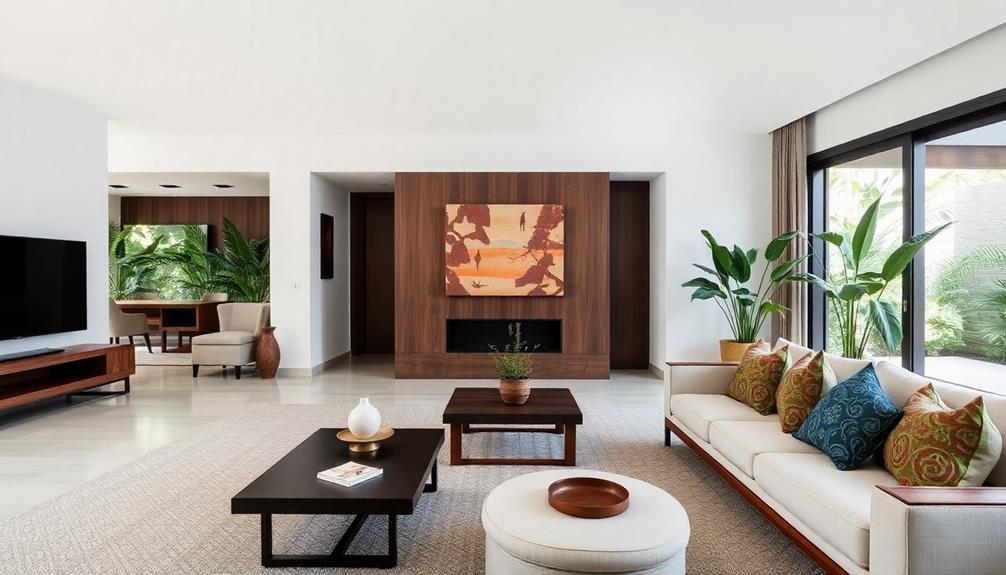
When you explore modern Indonesian interior design, you'll notice how it seamlessly integrates cultural heritage with contemporary elements.
The emphasis on blending indoor and outdoor environments, as seen in modern tropical aesthetics, highlights the importance of natural light and airflow.
The focus on sustainable materials and open-concept spaces not only enhances functionality but also creates a connection to the stunning environment.
This innovative approach allows you to experience a unique blend of tradition and modernity in your living spaces.
Cultural Heritage Integration
Blending traditional elements with contemporary design, modern Indonesian interior design creates spaces that resonate with cultural heritage while embracing innovation.
You'll find that cultural heritage integration is at the heart of this style, where intricate carvings and natural materials like teak and bamboo play pivotal roles. These materials not only add authenticity but also enhance the overall aesthetic of your home.
Decorative elements like Indonesian decor masks further enrich the visual narrative, embodying local myths and traditions.
Vibrant colors come alive through the use of traditional textiles, such as batik and ikat, which provide a striking contrast in upholstery and decor. This fusion of old and new reflects a deep respect for Indonesia's rich history while allowing for modern expression.
Innovations like open-air layouts and large glass windows invite natural light, blurring the lines between indoor and outdoor living. This design approach embodies the Balinese philosophy of harmony with nature, making your space feel more connected to the environment.
Sustainable practices are also key, with eco-friendly materials and technologies being thoughtfully integrated.
These choices honor traditional values of environmental respect while ensuring your living space remains contemporary and stylish, showcasing the beauty of modern Indonesian interior design.
Sustainable Material Choices
Modern Indonesian interior design not only celebrates cultural heritage but also embraces sustainability through thoughtful material choices.
You'll find that sustainable material choices often prioritize local resources, like bamboo, teak wood, and volcanic stone. These options reduce environmental impact while supporting local economies.
For instance, luxury tropical design aesthetics often incorporate high-quality materials sourced locally, ensuring both elegance and sustainability. By opting for eco-friendly materials such as recycled wood and natural fibers in furnishings and textiles, you not only promote sustainability but also reflect Indonesia's rich cultural heritage.
Innovations like the Shou-Sugi-Ban technique enhance the durability of wood while maintaining the traditional aesthetic in contemporary designs. Incorporating natural finishes and non-toxic paints contributes to healthier indoor environments, aligning perfectly with the trend of wellness-focused living spaces.
Moreover, designers increasingly utilize solar panels and rainwater harvesting systems in their projects. This showcases a commitment to sustainability and helps reduce the overall carbon footprint of modern homes.
Open-Concept Spaces
Open-concept spaces in modern Indonesian interior design create a harmonious connection between indoor and outdoor living.
These designs emphasize the importance of natural ventilation and light, utilizing large windows and sliding doors to blur the boundaries between your home and the vibrant outdoors.
Drawing inspiration from traditional Balinese architecture, open layouts foster community interaction while allowing you to enjoy the surrounding nature.
Additionally, integrating natural materials like bamboo aligns with the focus on sustainable architecture found in tropical villa plans, enhancing both aesthetics and environmental responsibility.
Here are some key features of open-concept spaces:
- Flexible Room Arrangements: Adapt your space for various activities, making it functional for modern lifestyles.
- Sustainable Materials: Incorporate bamboo and reclaimed wood, aligning with eco-friendly practices and Balinese philosophy.
- High-End Finishes: Experience the elegance of contemporary furniture that complements traditional craftsmanship.
- Community Focus: Encourage social interactions while maintaining a connection to cultural heritage.
Key Features of Balinese Aesthetics
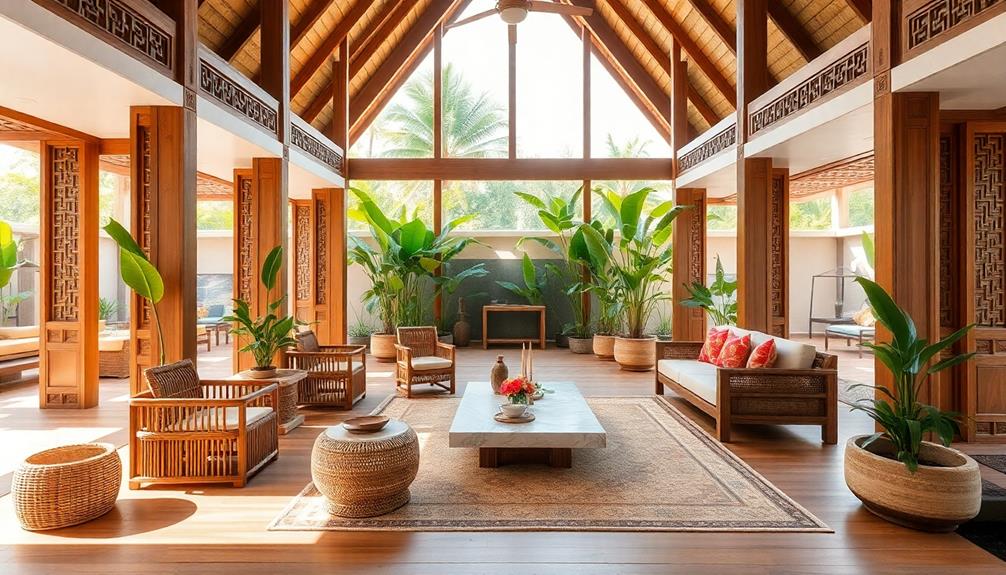
When exploring the key features of Balinese aesthetics, you'll notice a strong emphasis on natural materials that create warmth and sustainability in interior design. Elements like bamboo, teak wood, and volcanic stone are frequently used, enhancing the connection to the environment.
This approach not only promotes eco-friendliness but also gives interiors a cozy, inviting feel, reflecting the principles of traditional Indonesian housing.
Open-air designs are another hallmark of Balinese aesthetics. These layouts blur the lines between indoor and outdoor spaces, allowing for natural airflow and a seamless connection with nature. You'll find that this design choice enhances the overall ambiance and comfort of any room.
Earthy tones dominate the color palette, incorporating hues inspired by the natural environment, such as browns and greens. You might also spot vibrant accents like deep reds and golds that add a touch of warmth.
Additionally, traditional textiles like batik and ikat are commonly featured, bringing cultural significance and vibrant colors to furnishings and accessories.
Color Schemes and Atmosphere
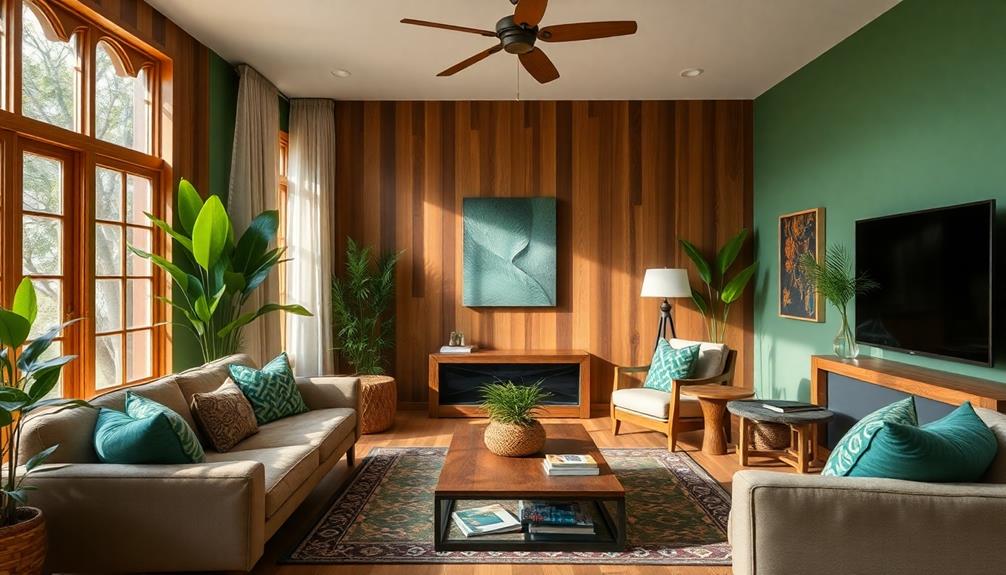
In Indonesian interior design, color schemes play an essential role in shaping the atmosphere of a space. You'll find that a cohesive color palette enhances the overall experience, creating a harmonious blend of modern aesthetics and traditional elements.
Dominant colors like white provide purity, while earthy tones such as browns and greens ground the design. To add energy, vibrant accents like deep reds and golds are often incorporated.
Consider these aspects to elevate your space:
- Natural materials: Use wood, stone, and textiles to connect with the environment.
- Cultural textiles: Integrate batik and ikat as upholstery or decor for added depth.
- Lighting: Guarantee large windows allow natural light to accentuate colors, enhancing vibrancy.
- Balance: Aim for a mix of tranquility and liveliness in your color choices.
Integrating Nature in Interiors
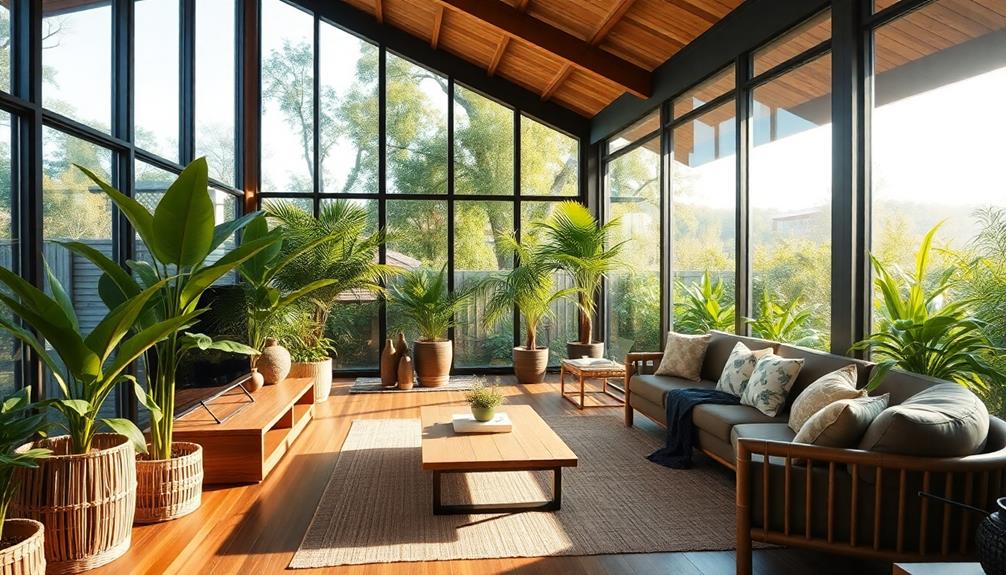
Integrating nature into modern Indonesian interiors is essential for creating spaces that feel alive and connected to the environment. You can achieve this by using natural materials like wood, stone, and bamboo, which not only add warmth but also resonate with the surroundings.
Emphasize open-air designs by incorporating large windows and sliding doors that blur the lines between indoor and outdoor areas, allowing natural light to flood your space and inviting the outdoors in.
Tropical plants, such as palms and ferns, play a significant role in enhancing air quality and reinforcing your interior's natural aesthetic. By strategically placing these plants throughout your home, you create a lush, vibrant atmosphere.
Additionally, consider adding water features like ponds or fountains to introduce calming sounds, enhancing the tranquil ambiance of your space.
For flooring, using textural materials like volcanic rock or river stone adds an organic feel, grounding your interiors in the natural landscape.
This thoughtful integration of nature not only promotes relaxation but also fosters a deep connection to the beautiful Indonesian environment, making your home a true sanctuary.
Case Studies of Iconic Designs
Exploring iconic designs in modern Indonesian interior architecture reveals a rich tapestry of tradition and innovation.
You'll find that these spaces not only serve functional living needs but also reflect a deep respect for cultural heritage.
Let's look at two standout examples:
– Villa Rumah Fajar: Designed by Studio Jencquel, this villa showcases a modern take on Balinese longhouses, utilizing local materials and traditional techniques.
The design offers stunning panoramic views of Gunung Agung, blending nature with contemporary living.
– Stupa House: Created by Realrich Architecture Workshop, this home integrates traditional stupa architecture with modern forms.
It features innovative skylights that enhance natural light and ventilation, creating an oasis-like environment.
Large glass openings allow for breathtaking panoramic views while maintaining seamless air circulation.
Both designs incorporate intricate carvings and locally sourced materials, ensuring that the essence of Balinese homes is preserved.
These elements beautifully demonstrate how modern Indonesian interior design can capture the heart of tradition while embracing contemporary aesthetics. By blending natural materials like teak wood, rattan, and bamboo with sleek furniture and artistic decor, it creates a harmonious balance between old and new. Incorporating vibrant textiles and traditional patterns also adds warmth and richness to any space. For those looking to adopt this style, some key *Indonesian interior design tips* include focusing on minimalistic layouts that allow traditional elements to stand out and choosing a neutral color palette inspired by nature.
Frequently Asked Questions
What Are the Best Materials for Modern Indonesian Furniture?
When choosing materials for modern furniture, consider sustainable woods like teak or bamboo, alongside metal and glass for a sleek look. These options blend durability with style, enhancing your space while respecting the environment.
How Can I Incorporate Batik Into My Home Decor?
Why not infuse your space with vibrant batik patterns? You can use batik cushions, wall art, or table runners, transforming your decor into a stunning blend of tradition and modernity that reflects your unique style.
Are There Specific Color Palettes for Indonesian Design?
Yes, Indonesian design often features earthy tones like browns, greens, and warm neutrals, alongside vibrant colors like deep reds and golds. You can mix these palettes to create a rich, inviting atmosphere in your space.
What Are Common Mistakes to Avoid in Indonesian Interior Design?
When designing Indonesian interiors, avoid over-cluttering spaces, neglecting local materials, and ignoring cultural significance. Don't overlook lighting; it sets the mood. Embrace balance and harmony instead, ensuring your design reflects both functionality and tradition.
How Can I Find Authentic Indonesian Craftsmanship for My Home?
To find authentic Indonesian craftsmanship for your home, explore local markets, visit artisan workshops, and connect with craftspeople online. You'll discover unique pieces that reflect the rich heritage and creativity of Indonesian culture.
Conclusion
In blending contemporary styles with traditional Indonesian elements, you're creating spaces that resonate with both history and modernity. Imagine walking into a home where a sleek, minimalist design meets intricate batik textiles, evoking a sense of warmth and cultural pride. This harmonious fusion not only enhances the aesthetic but also tells a story, reminding you of the rich heritage that shapes your surroundings. Embrace this beautiful journey of design, and let your space reflect the heart of Indonesia.
